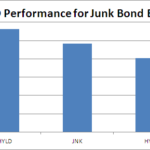Netflix (NFLX) may be this year’s best performer as a provider of internet TV, but investors are seeing impressive gains in media as a whole.
PowerShares Dynamic Media Portfolio (PBS) ranks among several leveraged funds and Japanese equity ETFs as a top YTD performer. The fund tracks an index of 32 different media companies, most of which are in traditional cable programming businesses. The fund is up 20% year-to-date as investment capital flocks to strong media outlets.

What’s right for media?
Media companies are difficult to value. Companies like Discovery Communications Inc (DISCA) and Walt Disney Co (DIS), the two largest holdings in the PBS fund, derive their value from their content and intellectual property. Media companies cannot make more cash flow-producing intellectual property at the snap of their fingers.
Walt Disney, for instance, has a roster of highly-valuable characters and franchises, from Toy Story to Mickey Mouse, as well as a successful cable business led by ESPN.
Here’s why investment capital flocks to media companies:
- Consumer discretionary plays are “in” – Media companies are classified as consumer discretionary, but they might as well be consumer staples. This year, and for much of the past decade, consumer staples have been a favorite of investors for their consistent revenue and bottom line profits.
- Subscription models are for the long haul – Cable operators make money on subscription. ESPN is the leader of creating value from cable companies. It typically charges $4.69 per subscriber, while other channels receive pennies per cable subscription. Customers do not come and go. Once signed, a cable contract pays out for decades.
- Higher revenue for cable brings opportunity – Cable companies like Comcast are dealing with the slow decline in cable with higher prices. Cord-cutting begets higher prices for remaining subscribers, while content creators see price hikes as a way to grab more income from cable companies. The difference between what a cable company pays for content and the average cable price per subscriber is money content creators eventually pull for their own.
- Advertising is heaviest in strong markets – The PBS fund has some exposure to advertising. Its position in Yahoo and Google, for instance, is a pure-play on growing internet advertising spend. As the economy recovers, businesses that rely on a marginal increase in ad spend rally due to operating leverage.
Prominent investors have always been in the media market. Warren Buffett’s Berkshire Hathaway (BRK.B) has significant stakes in Direct TV (DTV), The Washington Post (WPO), Viacom (VIAB), and Stars (STRZA).
Why the Media ETF Makes Sense
Unlike other sector ETFs, a media portfolio offers excellent opportunity because of a lack of price competition. Whereas two retailers can destroy one another through price wars, movies, cable content, and online advertising are markets where competitors rarely compete on price. There is an established market value for advertising, and rival movie producers do not seek to attract audiences with lower ticket prices. Businesses in the space compete mostly on product quality, which lifts the industry as a whole without the destructive effects of price competition.
As a group, the 32 media companies in PBS’s portfolio offer excellent diversification. The top 10 holdings are as follows:
- Discovery Communications (DISCA) 5.19%
- Walt Disney (DIS) 5.01%
- Yahoo (YHOO) 5.00%
- Time Warner (TWX) 5.00%
- Google(GOOG) 4.99%
- CBS (CBS) 4.99%
- Time Warner Cable (TWC) 4.98%
- Comcast Corp (CMCSA) 4.97%
- Lamar Advertising (LAMR) 2.88%
- Netflix (NFLX) 2.84%
In just the top 10 grouping, Powershares positions investors for exposure to movies, cable content, online advertising, outdoor advertising, and internet and cable TV. The fund has outperformed the S&P 500 index in all relevant periods from YTD performance to the last five years.
Investors who want a strong portfolio in the consumer discretionary space should certainly consider a position in media. The business is certainly changing – Netflix is trying to usurp Comcast and traditional media, while advertising shifts from commercials to product placement – but the profits are not. Media is a cash cow, and this fund is certainly worth owning for those who want broad exposure to the industry at a manageable price of .63% per year.
Disclosure: No position in any tickers mentioned here.











{ 0 comments… add one now }